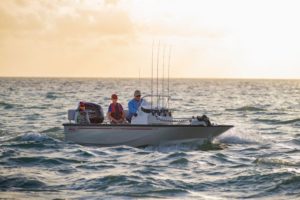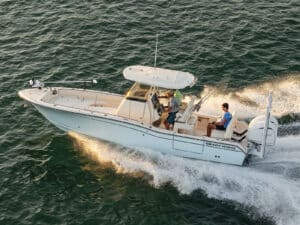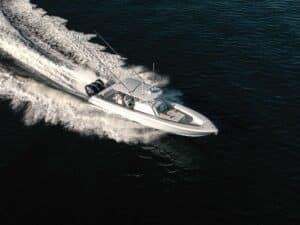
I recently re-powered my 21½-foot center-console with a 200-horsepower outboard and assisted in the installation so I might better understand the nuances of proper setup of an outboard motor.
Of course, most boating anglers don’t install and mount outboard motors. On many new boats, power comes pre-installed. That means outboards are rigged and fine-tuned to optimize performance right out of the gate.
Other boats, however, are delivered without power, and the dealer does the outboard installation. A dealer usually handles re-powers as well.
Customers are wise to rely heavily on the advice of their marine engine dealer. Yet it’s good to know the basics of outboard setup so you understand, for example, why the dealer might recommend changing the outboard motor mounting height of the new outboard.
Based on what I learned in the process of wrenching on outboards and talking with representatives from major engine brands, here are topics you might want to discuss with the dealer who rigs your next motor. To keep things simple, I focus largely on single-outboard applications, but the same principles apply to multi-engine installations.
If you’re re-powering an older boat, have the transom checked for rot once the old motor is off. An aging boat with laminated plywood in the transom (most new boats use advanced coring materials and lamination processes) is prone to deterioration over time from water seeping into the wood. Ask your dealer to check the structural integrity of the transom. Don’t mount an outboard motor to a rickety transom. If the transom is bad, you need to decide whether to rebuild it before the new power is installed or look for a new boat, depending on the cost-benefit analysis of the repairs and new motor versus the price of another boat.
This is also a good time to replace elements such as a corroded transom rail cap or other pieces you can’t otherwise access with the motor installed. If the dealer tells you the transom is sound, make sure he uses a top-quality marine bedding compound designed for use below the waterline, such as 3M 4000 or BoatLife LifeSeal, to seal the bolt holes when installing and mounting the new motor. This will prevent water intrusion.
Avoid high-strength sealants such as 3M 5200, or else you’ll almost have to pry off the engine with a crowbar on future re-powers. If re-powering, insist on all new bolts, washers and nuts, as the old hardware may have corroded, stretched or fatigued during the time you ran your old engine.

Setting the Outboard Height
Setting the Outboard Motor Height
The height of the outboard is one of the most critical elements of setup, and that’s why outboards have a series of vertically aligned mounting holes on the motor bracket, allowing for adjustment of the engine height. Some bay boats and flats skiffs also have jack plates to facilitate adjustments in outboard motor height.
If the outboard is too low, it creates excessive drag, which cuts into speed and fuel efficiency. If it’s too high, the propeller tends to ventilate, losing its bite on the water and blowing out while turning and in steep seas.
“If the prop consistently ventilates when heading down a steep wave, the outboard is probably set too high,” says Dean Corbisier, advertising and public relations manager for Suzuki Marine.
A dealer might guess at the optimum outboard motor mounting height by aligning the anti-ventilation plate slightly above or at the same level as the bottom of the boat. Or he might rely on his experience in rigging the same boat-and-motor combinations.
Sometimes, when re-powering with the same model motor, you can determine the best height for your outboard before you take off the old one, assuming the old engine is still running well, says Corbisier.
“To find out if your existing outboard is set at the best possible height, start with the engine in idle, and trim the outboard out one-half to nearly full trim,” Corbisier explains. “Then safely accelerate at a brisk pace.” If the propeller does not ventilate during this exercise, the engine is set too low on the transom, which means you probably want to raise it a peg or two. If it ventilates, you can likely use the same mounting holes for a same-model replacement, says Corbisier.
Gear-Case Changes When Mounting a New Motor
The relative size of the new engine’s gear case might call for a change in outboard height, says Chris Chapman, manager of outboard applications for Mercury Marine. Chapman points to Mercury’s original Verado and OptiMax outboards, which featured 4.8-inch-diameter gear cases. With a few exceptions, these models now feature larger, 5.44-inch-diameter gear cases for greater durability when powering today’s supersize center-consoles.
“The bigger cases create more lift and run higher than the older, smaller ones,” Chapman explains. So if the replacement Verado or OptiMax has the larger gear case, you want to mount it at least one hole higher (placing the outboard lower) than the previous motor for optimum fuel efficiency and speed.
But, Chapman warns, “You definitely don’t want the anti-ventilation plate below the bottom of the boat.” It acts like a planing surface that lifts the stern and pushes the bow downward.
Prop Considerations When Mounting A New Outboard Motor
The combination of setup parameters — including horsepower, outboard height and gear-case diameter — will also affect the choice of propeller. “It’s all interrelated,” says Corbisier. “Each element influences the other.”
Generally speaking, if you raise the engine height, you can add propeller pitch, the theoretical linear distance that a propeller travels with each revolution. “Adding pitch can further improve fuel efficiency and speed,” Corbisier points out.
Yet the converse also holds true. “If you need to lower the outboard, you might also need to go with less propeller pitch,” he adds.
Ultimately, my experience and research taught me that effective outboard setup is a combination of educated guesswork and field-testing. Only through sea trials and subsequent adjustments can you fine-tune outboard performance. Thank goodness major boatbuilders do all of this for us before delivering the finished product.








